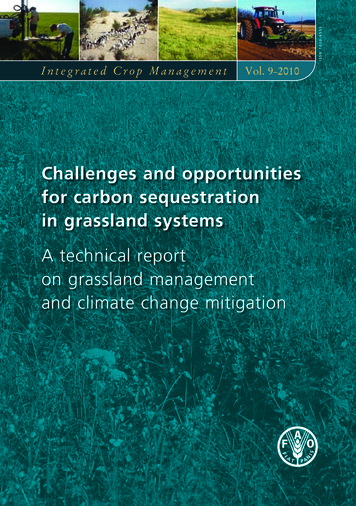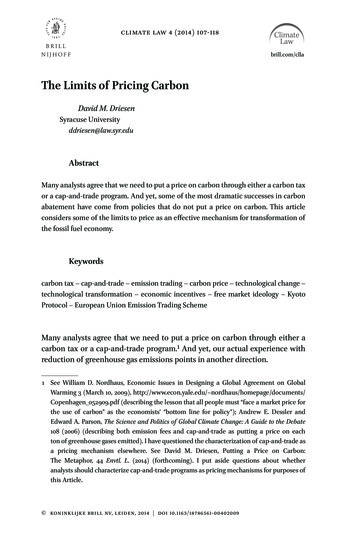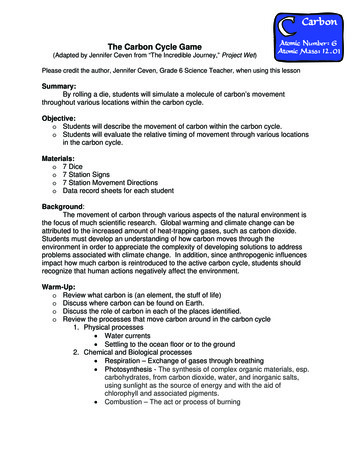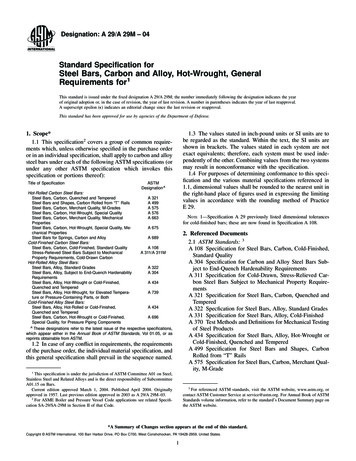
Transcription
ISSN 1020-4555Integrated Crop ManagementVol. 9 – 2010Challenges and opportunitiesfor carbon sequestrationin grassland systemsA technical reporton grassland managementand climate change mitigation
I n t e g r a t e d C r o p M a n a g e m e n t Vol. 9–2010Challenges and opportunitiesfor carbon sequestration ingrassland systemsA technical report ongrassland management andclimate change mitigationPrepared for thePlant Production and Protection DivisionFood and Agriculture Organization of the United Nations (FAO)Compiled byRichard T. ConantColorado State UniversityFort Collins, United States of AmericaFood and Agriculture Organization of the United NationsRome, 2010
The designations employed and the presentation of material in this information product do not implythe expression of any opinion whatsoever on the part of the Food and Agriculture Organization ofthe United Nations (FAO) concerning the legal or development status of any country, territory, cityor area or of its authorities, or concerning the delimitation of its frontiers or boundaries.The mention of specific companies or products of manufacturers, whether or not these have beenpatented, does not imply that these have been endorsed or recommended by FAO in preference toothers of a similar nature that are not mentioned.ISBN 978-92-5-106494-8All rights reserved. FAO encourages reproduction and dissemination of material in this informationproduct. Non-commercial uses will be authorized free of charge. Reproduction for resale or othercommercial purposes, including educational purposes, may incur fees.Applications for permission to reproduce or disseminate FAO copyright materials and all otherqueries on rights and licences, should be addressed by e-mail to copyright@fao.org or to the Chief,Publishing Policy and Support Branch, Office of Knowledge Exchange, Research and Extension, FAO,Viale delle Terme di Caracalla, 00153 Rome, Italy. FAO 2010Cover photos, from left to right: R. Conant, FAO/M.Marzot, FAO/J. Prontz, FAO/o.Thuillirt
CONTENTSvExecutive summaryChapter 11 IntroductionChapter 23 Background3Grasslands cover broad areas, contribute substantially to livelihoods and are vulnerable5Grasslands are intensively used and degradation is widespreadChapter 37 Opportunities7Carbon sequestration in grasslands14Reduced carbon emissions through reduced grassland degradation15Practices that sequester carbon in grasslands often enhance productivity19Practices that sequester carbon in grasslands can enhance adaptation to climate change20Potential income for practices that sequester carbonChapter 423 Challenges23Developing workable policies and incentives is difficult24Demonstrating additionality is a formidable challenge25Carbon sequestered in grassland systems is subject to reversals26Well-intentioned policies do not necessarily lead to good practices27Land tenure and governance issues complicate policy implementation28Systems for documenting carbon stock changes have not been agreed upon29Practice-based estimates of soil carbon sequestration30Combining measurement with mechanistic modelling31Data on management impacts on carbon stocks are limited in developing countriesChapter 533 The way forward33Foundations for sound policies35Grassland carbon sequestration in context35Research priorities38 references49 acknowledgements51 policy briefV ol. 9–2010iii
Executive SummaryImplementing grassland management practices that increase carbonuptake by increasing productivity or reducing carbon losses (e.g. throughhigh rates of offtake) can lead to net accumulation of carbon in grasslandsoils – sequestering atmospheric carbon dioxide (CO2). Globally, thepotential to sequester carbon by improving grassland practices orrehabilitating degraded grasslands is substantial – of the same order as thatof agricultural and forestry sequestration. Because practices that sequestercarbon in grasslands often enhance productivity, policies designed toencourage carbon sequestering grassland management practices couldlead to near-term dividends in greater forage production and enhancedproducer income.Practices that sequester carbon in grasslands also tend to enhanceresilience in the face of climate variability, and are thus likely to enhancelonger-term adaptation to changing climates. Developing policies toencourage the adoption of practices that sequester carbon has severalsignificant challenges, such as demonstrating additionality, addressingthe potential for losses of sequestered carbon, and engaging smallholdersand pastoralists with uncertain land tenure. In addition, the paucity ofdata in developing countries hampers the measurement, monitoring andverifying of carbon sequestration in response to those practices.This report reviews the current status of opportunities and challengesfor grassland carbon sequestration. Based on these observations, thereport then identifies components that could foster the inclusion ofgrasslands in a post-2012 climate agreement, and the development ofpolicies to improve grassland management.V ol. 9–2010v
S. Redfern
Chapter 1IntroductionThe implementation of improved land management practices to buildup carbon stocks in terrestrial ecosystems is a proven technology forreducing the concentration of carbon dioxide (CO2) in the atmosphere –offsetting emissions from other sources and drawing down atmosphericCO2. Developing effective policies capable of growing terrestrial carbonsinks is a serious challenge. Grassland carbon sequestration faces the samechallenges as those relating to forestry and agricultural sequestration,but in some ways they are greater. Sequestration rates can be slower,the ability to measure change could be more difficult, benefits may bedistributed across more landowners/land managers with less certaintenure, practices may be more varied, costs of implementation are morepoorly quantified, and the scientific information to inform policy analysisis less complete.The opportunities to benefit from grassland practices that sequestercarbon can be greater too. The large populations of people who dependdirectly on grasslands tend to be poor and vulnerable to climatevariability and climate change. Implementing practices to build – orrebuild – soil carbon stocks in grasslands could lead to considerablemitigation, adaptation and development benefits. However, the discussionof grassland carbon sequestration has lagged behind that of agricultureand forestry; forestry is an important, existing component of the CleanDevelopment Mechanisms (CDM) of the Kyoto Protocol.This report discusses the challenges that grassland sequestration facesand the substantial and diverse opportunities that arise with managementpractices that lead to carbon sequestration in grasslands. The reportconcludes by identifying key knowledge barriers and deriving a set ofrecommended activities and observations that can overcome them.V ol. 9–20101
FAO/d. miller
Chapter 2BackgroundGrasslands cover broad areas, contributesubstantially to livelihoods and are vulnerableGrasslands, including rangelands, shrublands, pastureland, and croplandsown with pasture and fodder crops, covered approximately 3.5 billion hain 2000, representing 26 percent of the world land area and 70 percent of theworld agricultural area, and containing about 20 percent of the world’s soilcarbon stocks (FAOSTAT, 2009; Ramankutty et al., 2008; Schlesinger, 1977).People rely heavily upon grasslands for food and forage production. Around20 percent of the world’s native grasslands have been converted to cultivatedcrops (Figure 1) (Ramankutty et al., 2008) and significant portions of worldmilk (27 percent) and beef (23 percent) production occur on grasslandsmanaged solely for those purposes. The livestock industry – largely based ongrasslands – provides livelihoods for about 1 billion of the world’s poorestpeople and one-third of global protein intake (Steinfeld et al., FAO, 2006).grazing landsWoodlandShrublandTall grassMedium grassShort grassSource: Connant and Paustian, 2000V ol. 9–20103
Challenges and opportunities for carbon sequestration in grassland systemsA Technical Report on Grassland Management and Climate Change MitigationS AmericaS AmericaN AmericaN nt)EuropeAsia (incl. FSU)Asia (incl. FSU)AfricaAfrica024681012% of total grassland/savannah areacropland024681012% of total shrubland areapastureFigure 1: Percentage of native grassland/savannah and shrubland that has beenconverted to cropland and pastureSource: Ramankutty et al., 2008The development challenges faced by the populations of the world’sdry grasslands systems vividly illustrate the tightening linkage betweenecosystem services and enhanced human well-being: 2 billion peopleinhabit dryland regions, yet dryland regions have only 8 percent of theworld’s renewable water supply. This means that people have access towater that meets only two-thirds of the minimum per capita requirements,population growth rates are faster in drylands than anywhere else, butproduction potential is lower than anywhere else. Traditional socioecological systems have evolved to cope with climatic and economicuncertainty, but population and economic pressures are increasinglytaxing traditional systems (Verstraete, Scholes and Stafford Smith, 2009).Primary production in rangelands is relatively low, varies substantiallyfrom place to place, and is strongly limited by precipitation (Le Houerou,1984). Even where rainfall is high (some grassland areas receive as muchas 900 mm of precipitation per year), almost all of the precipitation fallsduring distinct rainy seasons and evapotranspiration demands exceedprecipitation during most of the year. Moreover, precipitation, and thusproduction, varies considerably from year to year, with coefficients ofvariation averaging 33 percent, and as high as 60 percent in some of thedrier areas (Ellis and Galvin, 1994). Grasslands are thus highly vulnerableto climate change (Thornton et al., 2007; 2009).4I n t e g r a t e d C rop Man agem en t
backgroundGrasslands are intensively used anddegradation is widespreadA large part of the world’s grasslands is under pressure to producemore livestock by grazing more intensively, particularly in Africa’srangelands, which are vulnerable to climate change and are expectednonetheless to supply most of the beef and milk requirements in Africa(Reid et al., 2004). As a result of past practices, 7.5 percent of theworld’s grasslands have been degraded by overgrazing (Oldeman, 1994).Previous research has documented that improved grazing managementcould lead to greater forage production, more efficient use of landresources, and enhanced profitability and rehabilitation of degradedlands (Oldeman, 1994). The strong bond between ecosystem services andhuman well-being in the world’s dryland systems demonstrates the needfor a new, integrated approach to diagnosing and addressing sustainabledevelopment priorities, including maintenance of the supply of criticalecosystem services.One of the reasons for the intensive use of grasslands is the high naturalsoil fertility. Grasslands characteristically have high inherent soil organicmatter content, averaging 333 Mg1 ha-1 (Schlesinger, 1977). Soil organicmatter – an important source of plant nutrients – influences the fateof organic residues and inorganic fertilizers, increases soil aggregation,which can limit soil erosion, and also increases action exchange and waterholding capacities (Miller and Donahue, 1990; Kononova, 1966; Allison,1973; Tate, 1987). It is a key regulator of grassland ecosystem processes.Thus, a prime underlying goal of sustainable management of grasslandecosystems is to maintain high levels of soil organic matter and soilcarbon stocks.Portions of the grasslands on every continent have been degradedowing to human activities, with about 7.5 percent of grassland havingbeen degraded because of overgrazing (Oldeman, 1994). More recently,the Land Degradation Assessment in Drylands (LADA) concluded thatabout 16 percent of rangelands are currently undergoing degradation andthat rangelands comprise 20–25 percent of the total land area currently1mega gramsV ol. 9–20105
FAO/m. marzotChallenges and opportunities for carbon sequestration in grassland systemsA Technical Report on Grassland Management and Climate Change Mitigationbeing degraded. This process affects the livelihoods of over 1.5 billionpeople worldwide (Bai et al., 2008). Present degradation is probably takingplace in addition to historic degradation (Bai et al., 2008). Cultivation ofnative grasslands has contributed substantially to the transfer of about0.8 Mg of soil carbon to the atmosphere annually (Schlesinger, 1990). Soilorganic matter losses due to conversion of native grasslands to cultivationare both extensive and well documented (Kern, 1994; Donigian et al.,1994; Follett, Kimble and Lal, 2001). Removal of large amounts ofaboveground biomass, continuous heavy stocking rates and other poorgrazing management practices are important human-controlled factorsthat influence grassland production and have led to the depletion of soilcarbon stocks (Conant and Paustian, 2002a; Ojima et al., 1993). However,good grassland management can potentially reverse historical soil carbonlosses and sequester substantial amounts of carbon in soils.6I n t e g r a t e d C rop Man agem en t
Chapter 3OpportunitiesCarbon sequestration in grasslandsDisturbance – defined as removing biomass, changing the vegetationor altering soil function – is an integral part of traditional grasslandmanagement systems, which fosters dependable yields of forage.However, disturbance through overgrazing, fire, invasive species, etc.can also deplete grassland systems of carbon stocks (Smith et al., 2008).Harvesting a large proportion of plant biomass enhances yields of usefulmaterial (e.g. for forage or fuel), but decreases carbon inputs to the soil(Figure 2) (see Box 1) (Wilts et al., 2004).Primary production in overgrazed grasslands can decrease if herbivoryreduces plant growth or regeneration capacity, vegetation density andcommunity biomass, or if community composition changes (Chapmanand Lemaire, 1993). If carbon inputs to the soil in these systems decreasebecause of decreased net primary production or direct carbon removal bylivestock, soil carbon stocks will decline.Like carbon sequestration in forests or agricultural land, sequestrationin grassland systems – primarily, but not entirely in the soils – is broughtabout by increasing carbon inputs. It is widely accepted that continuousexcessive grazing is detrimental to plant communities (Milchunas andLauenroth, 1993) and soil carbon stocks (Conant and Paustian, 2002a).When management practices that deplete soil carbon stocks are reversed,grassland ecosystem carbon stocks can be rebuilt, sequestering atmosphericCO2 (Follett, Kimble and Lal, 2001).V ol. 9–20107
Challenges and opportunities for carbon sequestration in grassland systemsA Technical Report on Grassland Management and Climate Change MitigationCO2CO2system cCO2Native / undisturbedgrasslandsPoor management / degradedgrasslandsImprovedmanagementfigure 2: Conceptual diagram illustrating how past land management has led todepletion of grassland soil carbon stocks due to practices that decreasecarbon uptake. Implementation of improved management practices canlead to enhanced carbon uptake, restoring ecosystem carbon stocks andsequestering atmospheric CO2 in grassland soils.Box 1: Carbon stocks are a function of carbon inputs and outputsAll ecosystems – forested ecosystems, agro-ecosystems, grasslandecosystems, etc. – take up atmospheric CO2 and mineral nutrients andtransform them into organic products. In grasslands, carbon assimilationis directed towards the production of fibre and forage by manipulatingspecies composition and growing conditions. Ecosystems are a majorsource and sink for the three main biogenic greenhouse gases (GHG) –CO2, nitrous oxide (N2O) and methane (CH4). In undisturbed ecosystems,the carbon balance tends to be positive: carbon uptake throughphotosynthesis exceeds losses from respiration, even in mature, oldgrowth forest ecosystems (Luyssaert et al., 2008; Gough et al., 2008;8I n t e g r a t e d C rop Man agem en t
opportunitiesStephens et al., 2007). Disturbance, such as fire, drought, disease orexcessive forage consumption by grazing, can lead to substantial losses ofcarbon from both soils and vegetation (Page et al., 2002; Ciais et al., 2005;Adams et al., 2009). Disturbance is a defining element of all ecosystemsthat continues to influence the carbon uptake and losses that determinelong-term ecosystem carbon balance (Randerson et al., 2002).Human land-use activities function much like natural activities in theirinfluence on ecosystem carbon balance. CO2 is produced when forestbiomass is burned, and soil carbon stocks begin to decline soon after soildisturbances (Lal, Kimble and Stewart, 2000). Like natural disturbances suchas fire and drought, land-use change affects vegetation and soil dynamics,often prompting further increased carbon releases and decreased carbonuptake. Deforestation, degradation of native grasslands and conversionto cropland have prompted losses of biomass and soil carbon of 450–800Gt/CO2 – equivalent to 30–40 percent of cumulative fossil fuel emissions(Houghton et al., 1983; DeFries et al., 1999; Marland, Boden and Andres,2000; Olofsson and Hickler, 2008) Emissions from conversion from foreststo cropland or other land use have dominated carbon losses fromterrestrial ecosystems (DeFries et al., 1999), but substantial amounts ofcarbon have been lost from biomass and soils of grassland systems as well(Shevliakova et al., 2009).The basic processes governing the carbon balance of grasslands aresimilar to those of other ecosystems: the photosynthetic uptake andassimilation of CO2 into organic compounds and the release of gaseouscarbon through respiration (primarily CO2 but also CH4 ).Biomass in grassland systems, being predominantly herbaceous (i.e.non-woody), is a small, transient carbon pool (compared to forest) andhence soils constitute the dominant carbon stock. Grassland systems canbe productive ecosystems, but restricted growing season length, droughtperiods and grazing-induced shifts in species composition or productioncan reduce carbon uptake relative to that in other ecosystems. Soil organiccarbon stocks in grasslands have been depleted to a lesser degree than forcropland (Ogle, Conant and Paustian, 2004), and in some regions biomasshas increased due to suppression of disturbance and subsequent woodyencroachment. Much of the carbon lost from agricultural land soil andbiomass pools can be recovered with changes in management practicesthat increase carbon inputs, stabilize carbon within the system or reducecarbon losses, while still maintaining outputs of fibre and forage.V ol. 9–20109
FAO/r. faidutti FAO/g. napolitano FAO/j. printzChallenges and opportunities for carbon sequestration in grassland systemsA Technical Report on Grassland Management and Climate Change Mitigation10I n t e g r a t e d C rop Man agem en t
opportunitiesMany management techniques intended to increase livestock forageproduction have the potential to augment soil carbon stocks, thussequestering atmospheric carbon in soils. Methods of improvedmanagement include fertilization, irrigation, intensive grazing managementand sowing of favourable forage grasses and legumes. Grasslandmanagement to enhance production (through sowing improved species,irrigation or fertilization), minimizing the negative impacts of grazing orrehabilitating degraded lands can each lead to carbon sequestration (Conantand Paustian, 2002a; Follett, Kimble and Lal, 2001; Conant, Paustian andElliott, 2001). Improved grazing management (management that increasesproduction) leads to an increase of soil carbon stocks by an average of 0.35Mg C ha-1 yr-1 (Conant, Paustian and Elliott, 2001).Agroforestry enhances carbon uptake by lengthening the growingseason, expanding the niches from which water and soil nutrients aredrawn and, in the case of nitrogen (N)-fixing species, enhancing soilfertility (Nair, Kumar and Nair, 2009). The result is that when agroforestrysystems are introduced in suitable locations, carbon is sequestered in thetree biomass and tends to be sequestered in the soil as well (Jose, 2009).Improved management in existing agroforestry systems could sequester0.012 Tg1 C yr-1 while conversion of 630 million ha of unproductive ordegraded croplands and grasslands to agroforestry could sequester as muchas 0.59 Tg C annually by 2040 (IPCC, 2000), which would be accompaniedby modest increases in N2O emissions as more N circulates in the system(see Box 2 for information on grassland emissions of other GHGs).Using seeded grasses for cover cropping, catch crops and morecomplex crop rotations all increase carbon inputs to the soil by extendingthe time over which plants are fixing atmospheric CO2 in croplandsystems. Rotations with grass, hay or pasture tend to have the largestimpact on soil carbon stocks (West and Post, 2002). Adding manureto soil builds soil organic matter in grasslands (Conant, Paustian andElliott, 2001). The synthesis by Smith et al. (2008) suggests that addingmanure or biosolids to soil could sequester between 0.42 and 0.76 t Cha-1 yr-1 depending on the region (sequestration rates tend to be greaterin moist regions than in dry). Rapid incorporation of manure into fields1Tg 1012gV ol. 9–201011
Challenges and opportunities for carbon sequestration in grassland systemsA Technical Report on Grassland Management and Climate Change MitigationBox 2: Full GHG accountingWhen mineral soil N content is increased by N additions (i.e. fertilizer),a portion of that N can be transformed into N2O as a by-product of twomicrobiological processes (nitrification and denitrification), and lost tothe atmosphere. Coincidental introduction of large amounts of easilydecomposable organic matter and NO3- from either a plough downof cover crop or manure addition greatly stimulates denitrificationunder wet conditions (Mosier, Syers and Freney, 2004). Some practicesintended to sequester atmospheric carbon in soil could prompt increasesin N2O fluxes.For example, fertilization increases soil mineral N concentrations,leading to increased N2O fluxes, particularly in wetter environments.N2O is the most potent biogenic GHG in terms of global warmingpotential, with a radioactive forcing 296 times that of CO2 (IPCC, 2001).Management activities that add mineral or organic N – fertilization,plant N2 fixation, manure additions, etc. – augment naturally occurringN2O emissions from nitrification and denitrification by 0.0125 kg N2Okg N applied-1 (Mosier et al., 1998). Agriculture contributes significantlyto total global N2O fluxes through soil emissions (35 percent of totalglobal emissions), animal waste handling (12 percent), nitrate leaching(7 percent), synthetic fertilizer application (5 percent), grazing animals(4 percent) and crop residue management (2 percent). Agriculture is thelargest source of N2O in the United States of America (78 percent of totalN2O emissions), Canada (59 percent) and Mexico (76 percent).CH4 emissions from ruminant animals comprise about one-third ofnon-CO2 GHG emissions from agriculture (IPCC, 2007a). To the extentthat practices that sequester carbon lead to increased stocking rates,CH4 fluxes would increase, potentially offsetting mitigation due tosequestration (Soussana et al., 2007). CH4 emissions from ruminant animalsare a measure of production inefficiency – more CH4 emitted means lessof the carbon consumed by livestock is converted to product (FAO, 2006;Leng, 1993). The complement is also largely true: increasing productionefficiency reduces CH4 emission. Consequently, investments to reduce CH4emissions will lead to increased production efficiency.12I n t e g r a t e d C rop Man agem en t
radedImprovedMedium inputHigh inputtropicalThese factors estimate proportional carbon sequestration or loss (i.e. through degradation) givendeparture from nominal management practices. Medium inputs require one external input (e.g.fertilizer improved species, etc.) whereas high inputs require more than one external input. Thesemanagement factors are presented as proportional increases in carbon stocks rather than carbonsequestration rates, so that the factors can be applied to all soils.Figure 3: Grassland management factors for temperate and tropical regionsSource: Figure reproduced from Ogle, Conant and Paustian, 2004would reduce the time that manure decomposes in anaerobic piles andlagoons, reducing emissions of CH4 and N2O. IPCC (2007a) estimatesthe technical potential for reduction of CH4 emissions from manure tobe 12.3 Tg C yr-1 by 2030; N2O emissions could also be reduced. Addingmanure in one place to build soil carbon stocks is offset by removal, orwhat would be carbon inputs in another place (by forage or feed harvest).The balance between these has not been well characterized. Summarydata synthesized by climate region are presented in Figure 3.Globally, an estimated 0.2—0.8 Gt2 CO2 yr-1 could be sequesteredin grassland soils by 2030, given prices for CO2 of USD20–50/tonne(IPCC, 2007a). Although both fertilization and fire management couldcontribute to carbon sequestration, most of the potential sequestrationin non-degraded grasslands is due to changes in grazing managementpractices. Estimated rates of carbon sequestration per unit are lowerthan those for sequestration on agricultural land, but sequestrationpotential is comparable to that of croplands because grasslands coversuch a large portion of the earth’s surface (Figure 4). Nearly 270million ha of grassland worldwide have been degraded to some degree2Gt 1015gV ol. 9–201013
Challenges and opportunities for carbon sequestration in grassland systemsA Technical Report on Grassland Management and Climate Change MitigationMt CO2-eq yr-11 0008006004002000croplandmgmtUSD t d landslivestockset-asideagroforestry 50Figure 4: Estimates of carbon sequestration potential for several mitigationmeasures at varying carbon pricesSource: IPCC, 2007aby mismanagement (Oldeman, 1994; Bridges and Oldeman, 1999).Much of this land can be rehabilitated by enhancing plant productivity,capturing water resources and using them more efficiently, or improvingsoil fertility; doing so could sequester about as much carbon as could besequestered in grasslands (0.15—0.7 Gt CO2 yr-1 depending on carbonprices) (IPCC, 2007a).Reduced carbon emissions throughreduced grassland degradationGrasslands contain a substantial amount of the world’s soil organiccarbon. Integrating data on grassland areas (FAOSTAT, 2009) andgrassland soil carbon stocks (Sombroek, Nachtergaele and Hebel, 1993)results in a global estimate of about 343 billion tonnes of C – nearly 50percent more than is stored in forests worldwide (FAO, 2007).Just as in the case of forest biomass carbon stocks, grassland soilcarbon stocks are susceptible to loss upon conversion to other land uses(Paustian, Collins and Paul, 1997) or following activities that lead tograssland degradation (e.g. overgrazing). Current rates of carbon lossfrom grassland systems are not well quantified. Over the last decade,the grassland area has been diminishing while arable land area has been14I n t e g r a t e d C rop Man agem en t
opportunitiesgrowing, suggesting continued conversion of grassland to croplands(FAOSTAT, 2009). When grasslands are converted to agricultural land,soil carbon stocks tend to decline by an average of about 60 percent(Paustian, Collins and Paul, 1997; Guo and Gifford, 2002).Grassland degradation has also expanded (Bai et al., 2008), probablycontributing to the loss of grassland ecosystem carbon stocks. Arrestinggrassland conversion and degradation would preserve grassland soilcarbon stocks. The magnitude of the impact on atmospheric CO2 ismuch smaller than that due to deforestation, but preserving grasslandsoil carbon stocks serves to maintain the productive capacity of theseecosystems that make a substantial contribution to livelihoods.Practices that sequester carbon in grasslandsoften enhance productivityAn important argument in favour of grassland carbon sequestrationis that implementation of practices to sequester carbon often lead toincreased production and greater economic returns. Forage removalpractices that disturb the system and prompt carbon losses usuallyreflect attempts to enhance forage utilization, but the complement isnot necessarily true: practices that sequester carbon do not necessarilyresult in reduced forage utilization.Reducing the amount of carbon inputs removed, or increasingproduction, carbon inputs or below-ground allocation, could all leadto increasing soil carbon stocks (Conant, Paustian and Elliott, 2001).Grazing management can lead to decreased carbon removal if grazingintensities are reduced or if grazing is deferred while forage species aremost actively growing (Kemp and Michalk, 2007). Sustainable grazingmanagement can thus increase carbon inputs and carbon stocks withoutnecessarily reducing forage production. Grazing management can alsobe used to restore productive forage species, further augmenting carboninputs and soil carbon stocks.Other practices that enhance production, such as sowing moreproductive species or supplying adequate moisture and nutrients, alsoresult in greater carbon uptake, ecosystem carbon stocks and forageproduction (Conant, Paustian and Elliott, 2001) (Box 3).V ol. 9–201015
Challenges and opportunities for carbon sequestration in grassland systemsA Technical Report on Grassland Management and Climate Change MitigationBox 3: Which grassland management practices increasecarbon
Carbon sequestered in grassland systems is subject to reversals Well-intentioned policies do not necessarily lead to good practices Land tenure and governance issues complicate policy implementation Systems for documenting carbon stock changes have not been agreed upon Practice-based estimates of soil carbon sequestration










